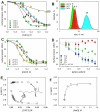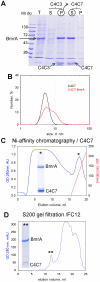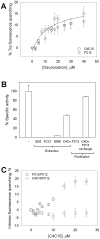Structuring detergents for extracting and stabilizing functional membrane proteins
- PMID: 21483854
- PMCID: PMC3069034
- DOI: 10.1371/journal.pone.0018036
Structuring detergents for extracting and stabilizing functional membrane proteins
Abstract
Background: Membrane proteins are privileged pharmaceutical targets for which the development of structure-based drug design is challenging. One underlying reason is the fact that detergents do not stabilize membrane domains as efficiently as natural lipids in membranes, often leading to a partial to complete loss of activity/stability during protein extraction and purification and preventing crystallization in an active conformation.
Methodology/principal findings: Anionic calix[4]arene based detergents (C4Cn, n=1-12) were designed to structure the membrane domains through hydrophobic interactions and a network of salt bridges with the basic residues found at the cytosol-membrane interface of membrane proteins. These compounds behave as surfactants, forming micelles of 5-24 nm, with the critical micellar concentration (CMC) being as expected sensitive to pH ranging from 0.05 to 1.5 mM. Both by 1H NMR titration and Surface Tension titration experiments, the interaction of these molecules with the basic amino acids was confirmed. They extract membrane proteins from different origins behaving as mild detergents, leading to partial extraction in some cases. They also retain protein functionality, as shown for BmrA (Bacillus multidrug resistance ATP protein), a membrane multidrug-transporting ATPase, which is particularly sensitive to detergent extraction. These new detergents allow BmrA to bind daunorubicin with a Kd of 12 µM, a value similar to that observed after purification using dodecyl maltoside (DDM). They preserve the ATPase activity of BmrA (which resets the protein to its initial state after drug efflux) much more efficiently than SDS (sodium dodecyl sulphate), FC12 (Foscholine 12) or DDM. They also maintain in a functional state the C4Cn-extracted protein upon detergent exchange with FC12. Finally, they promote 3D-crystallization of the membrane protein.
Conclusion/significance: These compounds seem promising to extract in a functional state membrane proteins obeying the positive inside rule. In that context, they may contribute to the membrane protein crystallization field.
Conflict of interest statement
Figures






References
-
- Overington JP, Al-Lazikani B, Hopkins AL. How many drug targets are there? Nat Rev Drug Discov. 2006;5:993–996. - PubMed
-
- White SH. Membrane Proteins of known 3D structure. 2009 Available: http://blanco.biomol.uci.edu/Membrane_Proteins_xtal.html. Accessed 2011 March 11.
-
- Seddon AM, Curnow P, Booth PJ. Membrane proteins, lipids and detergents: not just a soap opera. Biochim Biophys Acta. 2004;1666:105–117. - PubMed
Publication types
MeSH terms
Substances
LinkOut - more resources
Full Text Sources
Other Literature Sources

